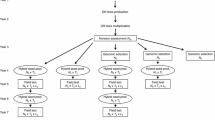Abstract
Key message
The use of a breeding strategy combining the evaluation of line per se with testcross performance maximizes annual selection gain for hybrid wheat breeding.
Abstract
Recent experimental studies confirmed a high commercial potential for hybrid wheat requiring the design of optimum breeding strategies. Our objectives were to (1) determine the optimum allocation of the type and number of testers, the number of test locations and the number of doubled haploid lines for different breeding strategies, (2) identify the best breeding strategy and (3) elaborate key parameters for an efficient hybrid wheat breeding program. We performed model calculations using the selection gain for grain yield as target variable to optimize the number of lines, testers and test locations in four different breeding strategies. A breeding strategy (BS2) combining the evaluation of line per se performance and general combining ability (GCA) had a far larger annual selection gain across all considered scenarios than a breeding strategy (BS1) focusing only on GCA. In the combined strategy, the production of testcross seed conducted in parallel with the first yield trial for line per se performance (BS2rapid) resulted in a further increase of the annual selection gain. For the current situation in hybrid wheat, this relative superiority of the strategy BS2rapid amounted to 67 % in annual selection gain compared to BS1. Varying a large number of parameters, we identified the high costs for hybrid seed production and the low variance of GCA in hybrid wheat breeding as key parameters limiting selection gain in BS2rapid.



Similar content being viewed by others
References
Cochran WG (1951) Improvement by means of selection. In: Proceedings of second Berkeley symposium on mathematical statistics and probability, pp 449–470
Gordillo GA, Geiger HH (2008) Alternative recurrent selection strategies using doubled haploid lines in hybrid maize breeding. Crop Sci 48:911–922
Gowda M, Longin CFH, Lein V, Reif JC (2012) Relevance of specific versus general combining ability in winter wheat. Crop Sci 52:2494–2500
Hallauer AR, Miranda JB (1981) Quantitative genetics in maize breeding. Iowa State University Press, Ames, pp 267–298
Hallauer AR, Russell WA, Lamkey KR (1988) Corn breeding. In: Sprague GF, Dudley JW (eds) Corn and corn improvement, 3rd edn. Agron Monogr 18. ASA, CSSA, SSSA, Madison, WI, pp 469–565
Kempe K, Gils M (2011) Pollination control technologies for hybrid breeding. Mol Breed 27:417–437
Kramer J (2003) Maiszüchtung für den weltweiten Markt. In: Bericht über die 54. Tagung der Vereinigung der Pflanzenzüchter und Saatgutkaufleute Österreichs, BAL Gumpenstein, pp 7–8 (in german)
Langer S, Longin CFH, Würschum T (2014) Phenotypic evaluation of floral traits with relevance for hybrid breeding in wheat (Triticum aestivum L.). Plant Breed 133:433–441
Longin CFH, Utz HF, Reif JC, Schipprack W, Melchinger AE (2006) Hybrid maize breeding with doubled haploids. I. One-stage versus two-stage selection for testcross performance. Theor Appl Genet 112:903–912
Longin CFH, Utz HF, Melchinger AE, Reif JC (2007) Hybrid maize breeding with doubled haploids. II. Optimum type and number of testers in two-stage selection for general combining ability. Theor Appl Genet 114:393–402
Longin CFH, Mühleisen J, Maurer HP, Zhang H, Gowda M, Reif JC (2012) Hybrid breeding in autogamous cereals. Theor Appl Genet 125:1087–1096
Longin CFH, Gowda M, Mühleisen J, Ebmeyer E, Kazman E, Schachschneider R, Schacht J, Zhao Y, Reif JC (2013) Hybrid breeding in wheat: heterosis, relevance of general and specific combining ability effects and consequences for optimum breeding strategies. Theor Appl Genet 126:2791–2801
Longin CFH, Reif JCR, Würschum T (2014) Long-term perspective of hybrid versus line breeding in wheat based on quantitative genetic theory. Theor Appl Genet 127:1635–1641
Melchinger AE, Longin CFH, Utz HF, Reif JCR (2005) Hybrid maize breeding with doubled haploid lines: quantitative genetic and selection theory for optimum allocation of resources. In: Proceedings of the 41st annual Illinois Corn Breeders School 2005, Urbana-Champaign, pp 8–21
Mi X, Utz HF, Technow F, Melchinger AE (2014) Optimizing resource allocation for multi-stage selection in plant breeding with R package selectiongain. Crop Sci 54:1413–1418
Mühleisen J, Piepho HP, Maurer HP, Longin CFH, Reif JC (2014) Yield stability of hybrids versus lines in wheat, barley and triticale. Theor Appl Genet 127:309–316
R Development Core Team (2011) R: a language and environment for statistical computing. R Foundation for Statistical Computing, Vienna. http://www.r-project.org
Ray DK, Mueller ND, West PC, Foley JA (2013) Yield trends are insufficient to double global crop production by 2050. PLoS One 8:e66428
Schmidt W (2003) Hybridmaiszüchtung bei der KWS SAAT AG. In: Bericht über die 54. Tagung der Vereinigung der Pflanzenzüchter und Saatgutkaufleute Österreichs, BAL Gumpenstein, pp 7–8 (in german)
Wegenast T, Utz HF, Longin CFH, Maurer HP, Dhillon BS, Melchinger AE (2008) Hybrid maize breeding with doubled haploids. IV. Number versus size of crosses and importance of parental selection in two-stage selection for testcross performance. Theor Appl Genet 117:251–260
Whitford R, Fleury D, Reif JC, Garcia M, Okada T, Korzun V, Langridge P (2013) Hybrid breeding in wheat: technologies to improve hybrid wheat seed production. J Exp Bot 64:5411–5428
Acknowledgments
We acknowledge the financial support by BMBF within the HYWHEAT project (Grant ID: FKZ0315945D). This paper is dedicated to one of the pioneers in selection theory in plant breeding, Prof. Dr. H. Friedrich Utz, on the occasion of his 75th anniversary. Thanks to two anonymous reviewers, whose suggestions largely improved the manuscript.
Conflict of interest
The authors declare that they have no conflict of interest.
Ethical standard
The authors declare that the experiments comply with the current laws of Germany.
Author information
Authors and Affiliations
Corresponding author
Additional information
Communicated by Mark E. Sorrells.
Rights and permissions
About this article
Cite this article
Longin, C.F.H., Mi, X., Melchinger, A.E. et al. Optimum allocation of test resources and comparison of breeding strategies for hybrid wheat. Theor Appl Genet 127, 2117–2126 (2014). https://doi.org/10.1007/s00122-014-2365-0
Received:
Accepted:
Published:
Issue Date:
DOI: https://doi.org/10.1007/s00122-014-2365-0




